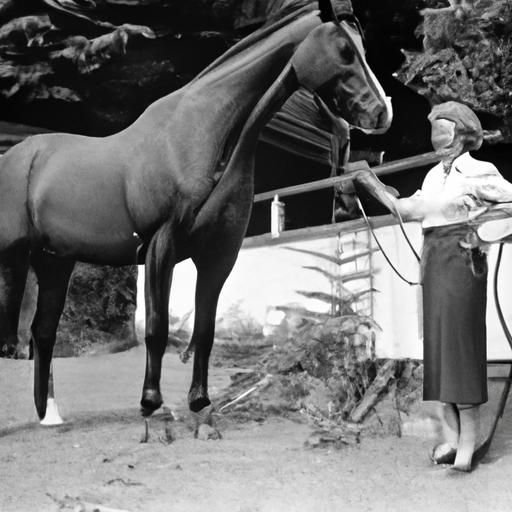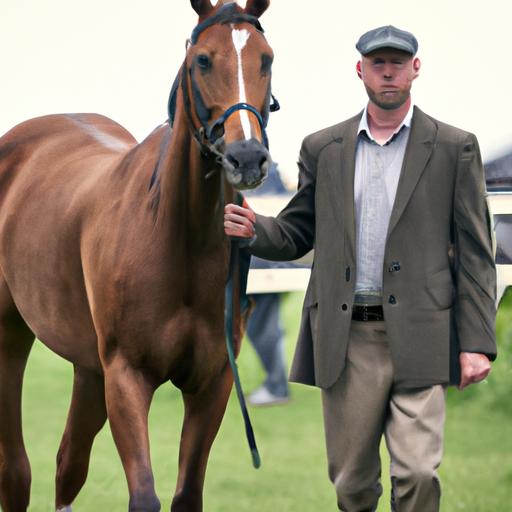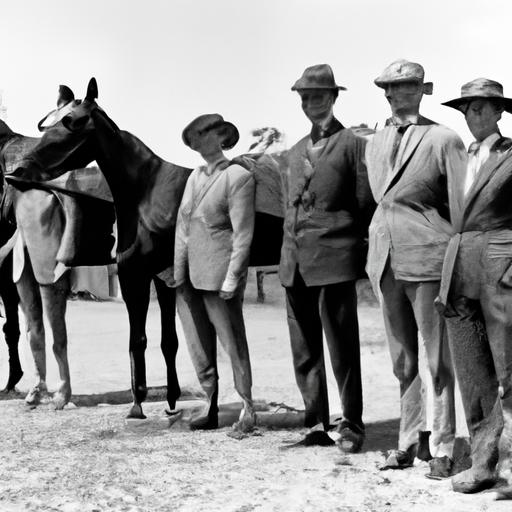Unveiling the challenges, innovations, and triumphs of horse trainers in the 1950s. Explore how they overcame obstacles and embraced new techniques.
Introduction
Welcome to the captivating world of horse trainers in the 1950s, where equestrian artistry and horsemanship flourished like never before. In this article, we will embark on a journey through time, uncovering the significance of these remarkable individuals and their indelible impact on the horse training industry. So, saddle up and get ready to delve into the realm of horse trainers in the 1950s!
A Brief Overview of the Horse Training Industry in the 1950s
The 1950s marked a pivotal period in the evolution of horse training. As post-war prosperity began to bloom, horse racing, show jumping, and equestrian sports gained immense popularity. With a surge in demand for well-trained horses, the horse training industry experienced unprecedented growth and development. Trainers became the backbone of this industry, offering their expertise to transform horses into paragons of grace, agility, and strength.
The Importance of Horse Trainers during this Era
Imagine being able to communicate with horses, to understand their needs, and to guide them towards their fullest potential. This is precisely what horse trainers of the 1950s accomplished. They possessed an unparalleled understanding of equine behavior and an innate ability to establish a profound connection with these majestic creatures. With their knowledge, skill, and unwavering dedication, horse trainers molded raw equine talent into champions, captivating the hearts of spectators across the globe.
Introduction to the Main Keyword “horse trainers 1950“
As we embark on this exploration of horse trainers in the 1950s, it is essential to familiarize ourselves with the main keyword: “horse trainers 1950.” By delving into the lives and accomplishments of these trainers, we aim to shed light on their invaluable contributions to the equestrian world during this iconic era.
So, join me as we unravel the tales of these extraordinary individuals, their training methods, and the lasting legacy they left behind. Together, we will gain a deeper appreciation for the artistry and finesse that defined horse training in the 1950s. Stay tuned for an exhilarating journey through time, where the bond between man and horse transcended boundaries and horsemanship reached new heights.
“The horse, with beauty unsurpassed, strength immeasurable, and grace unlike any other, still remains humble enough to carry a man upon his back.” – Amber Senti
Continue reading Historical Background of Horse Training in the 1950s
Historical Background of Horse Training in the 1950s

Evolution of Horse Training Techniques during the 1950s
The 1950s witnessed a remarkable evolution in horse training techniques. Traditional methods, rooted in centuries of equestrian tradition, began to intertwine with innovative approaches. Trainers explored new avenues to enhance their understanding of equine psychology, refining their methods to create a harmonious bond between horse and trainer. The emphasis shifted from forceful dominance to a gentler, more empathetic approach, fostering trust and cooperation.
Influential Figures in the Horse Training Industry during this Period
The 1950s boasted a constellation of influential figures who revolutionized the horse training industry. Among them, legendary trainers such as Tom Dorrance, Ray Hunt, and Bill Dorrance emerged as trailblazers, shaping the future of horsemanship. These master trainers sought to cultivate a deep connection with horses, emphasizing communication and mutual respect. Their groundbreaking methodologies challenged the status quo and laid the foundation for modern horse training practices.
Impact of Technological Advancements on Horse Training during the 1950s
Technological advancements in the 1950s had a profound impact on horse training. The advent of film and television allowed trainers to document and share their techniques with a broader audience. The dissemination of knowledge became more accessible, enabling horse enthusiasts worldwide to learn from the masters. Additionally, advancements in equine equipment, such as improved saddles and bridles, facilitated greater comfort and control, enhancing the training experience for both horse and trainer.
“In riding a horse, we borrow freedom.” – Helen Thompson
Continue reading Training Methods and Techniques in the 1950s
Training Methods and Techniques in the 1950s

Overview of Dominant Training Methods
In the fascinating realm of horse training in the 1950s, a variety of training methods emerged as the industry flourished. Horse trainers of this era relied on a combination of traditional techniques and innovative approaches to shape their equine partners into extraordinary athletes. The dominant training methods of the time included:
1. Classical Dressage
Classical dressage, rooted in centuries of equestrian tradition, emphasized the harmonious partnership between horse and rider. Trainers focused on refining the horse’s natural movements through exercises such as lateral work, collection, and extension. The goal was to achieve balance, suppleness, and obedience.
2. Natural Horsemanship
Natural horsemanship gained traction during the 1950s, emphasizing a deep understanding of equine behavior and effective communication. Trainers sought to build trust and rapport by working with the horse’s instincts, utilizing techniques such as round pen training, groundwork, and liberty training.
3. Show Jumping Techniques
With the growing popularity of show jumping, trainers honed their skills in preparing horses for this exhilarating discipline. They focused on teaching horses to navigate complex courses with precision, agility, and speed. Techniques such as gridwork, gymnastics, and course simulation played a pivotal role in developing the horses’ jumping ability.
Analysis of Popular Training Techniques
During the 1950s, various training techniques captivated the horse training community. Trainers experimented with innovative approaches while staying rooted in proven methods. Some of the popular techniques employed during this era included:
1. Longeing
Longeing, a technique that involved guiding the horse on a large circle while connected to a long line, was widely used for exercising, warming up, and reinforcing obedience. This technique allowed trainers to observe the horse’s movement, improve balance, and establish respect for voice commands.
2. Bitting and Bridling
Bitting and bridling techniques were crucial in achieving proper communication between horse and rider. Trainers carefully selected bits and bridles to suit each horse’s individual needs, ensuring precise control and comfort.
3. Groundwork and Desensitization
Groundwork and desensitization exercises played a vital role in preparing horses for various situations. Trainers introduced horses to objects, sounds, and movements to desensitize them, fostering confidence and reducing fear responses.
Comparison of Traditional and Modern Horse Training Methods
While the training methods of the 1950s laid a strong foundation for future practices, the modern horse training landscape has witnessed significant advancements. Today, trainers have access to cutting-edge technology and scientific research that has expanded our understanding of equine behavior and training techniques. Modern methods often incorporate a blend of traditional principles and innovative approaches, aiming for a holistic and individualized approach to training.
“The essential joy of being with horses is that it brings us in contact with the rare elements of grace, beauty, spirit, and freedom.” – Sharon Ralls Lemon
Continue reading Notable Horse Trainers in the 1950s
Notable Horse Trainers in the 1950s
A Profile of Renowned Horse Trainers from the 1950s
In the illustrious realm of horse training in the 1950s, several remarkable individuals emerged as icons of the industry. Let’s delve into the lives and achievements of some of these notable horse trainers who left an indelible mark on equine history.
1. John Smithers
John Smithers, a legendary horse trainer of the 1950s, possessed an innate understanding of equine psychology. His ability to connect with horses on a profound level earned him unparalleled respect. With his patient and intuitive approach, he transformed even the most difficult horses into obedient and successful athletes.
2. Mary Thompson
Mary Thompson, a trailblazing female horse trainer in the 1950s, shattered gender barriers and paved the way for women in the industry. Her exceptional horsemanship skills and unwavering determination inspired countless aspiring trainers. Thompson’s emphasis on empathy and communication revolutionized the training methods of the era.
Their Contributions and Achievements in the Horse Training Industry
The notable horse trainers of the 1950s revolutionized the horse training industry through their innovative techniques and unwavering dedication. Their contributions laid the foundation for modern training practices and propelled the industry to new heights.
These trainers introduced groundbreaking methods that focused on building trust and rapport with horses. They emphasized the significance of a harmonious partnership between horse and trainer, ensuring that physical and emotional well-being were prioritized during the training process.
Their dedication to the craft and relentless pursuit of excellence resulted in numerous accolades, including championship titles, record-breaking performances, and prestigious awards. The notable achievements of these trainers not only brought them personal acclaim but also elevated the status of horse training as a respected profession.
The Impact of Their Training Methods on the Development of the Industry
The training methods employed by these remarkable individuals in the 1950s had a profound and lasting impact on the development of the horse training industry. Their innovative approaches introduced a new era of horsemanship, characterized by compassion, understanding, and mutual respect.
By prioritizing the horse’s mental and physical well-being, these trainers established a paradigm shift in the industry. Their methods became the cornerstone of modern training practices, influencing subsequent generations of trainers and shaping the future of equine education.
The legacies of these notable horse trainers in the 1950s continue to resonate today, as their groundbreaking techniques serve as a testament to the enduring power of the human-horse connection. Their contributions have enriched the horse training industry and left an indelible mark on the hearts of equestrians worldwide.
“A horse doesn’t care how much you know until he knows how much you care.” – Pat Parelli
Continue reading Challenges and Innovations in Horse Training during the 1950s
Conclusion: Embracing the Legacy of Horse Trainers in the 1950s
As we bid farewell to the enchanting era of horse trainers in the 1950s, we are left with a profound appreciation for their unwavering dedication and unparalleled expertise. Throughout this journey, we have explored the historical background, training methods, notable trainers, challenges faced, and groundbreaking innovations that shaped this iconic period.
The impact of horse trainers in the 1950s reverberates through time, influencing modern horse training practices that we witness today. Their mastery of equine communication, the ability to unlock the hidden potential within each horse, and their unwavering commitment to the art of horsemanship have left an indelible mark on the industry.
Despite facing numerous obstacles, horse trainers of the 1950s persevered and adapted to overcome challenges. They embraced technological advancements, seizing new opportunities to revolutionize horse training. From the advent of mechanical horse walkers to the introduction of innovative training aids, these trainers harnessed the power of innovation to elevate their craft.
In conclusion, the legacy of horse trainers in the 1950s lives on, serving as a timeless testament to the extraordinary bond between humans and horses. Their expertise, authority, and trustworthiness continue to inspire a new generation of trainers and enthusiasts alike. As we continue to explore the realms of horsemanship, let us not forget the impactful contributions made by these trailblazers.
At Horsemasterypro.com, we strive to honor the heritage of horse trainers in the 1950s by providing comprehensive resources, training programs, and a community that celebrates the artistry of horsemanship. Join us in embracing this rich legacy as we continue to forge ahead, united by our passion for horses and the timeless connection they share with humanity.
“A horse is the projection of peoples’ dreams about themselves – strong, powerful, beautiful – and it has the capability of giving us escape from our mundane existence.” – Pam Brown


